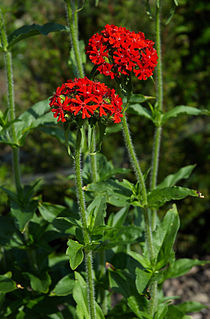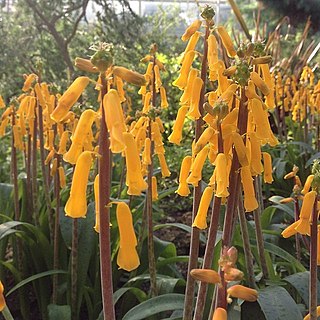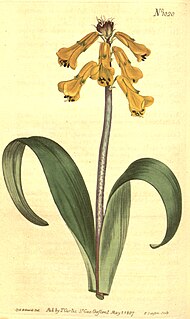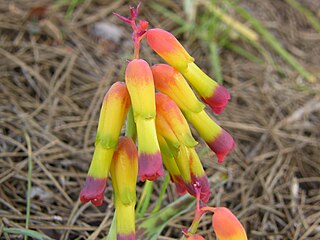
Salvia rosmarinus, commonly known as rosemary, is a woody, perennial herb with fragrant, evergreen, needle-like leaves and white, pink, purple, or blue flowers, native to the Mediterranean region. Until 2017, it was known by the scientific name Rosmarinus officinalis, now a synonym.

Iris is a genus of 260–300 species of flowering plants with showy flowers. It takes its name from the Greek word for a rainbow, which is also the name for the Greek goddess of the rainbow, Iris. Some authors state that the name refers to the wide variety of flower colors found among the many species. As well as being the scientific name, iris is also widely used as a common name for all Iris species, as well as some belonging to other closely related genera. A common name for some species is 'flags', while the plants of the subgenus Scorpiris are widely known as 'junos', particularly in horticulture. It is a popular garden flower.

Pelargonium is a genus of flowering plants which includes about 280 species of perennials, succulents, and shrubs, commonly known as geraniums, pelargoniums, or storksbills. Geranium is also the botanical name and common name of a separate genus of related plants, also known as cranesbills. Both genera belong to the family Geraniaceae. Carl Linnaeus originally included all the species in one genus, Geranium, and they were later separated into two genera by Charles Louis L'Héritier de Brutelle in 1789.

Agapanthus is the only genus in the subfamily Agapanthoideae of the flowering plant family Amaryllidaceae. The family is in the monocot order Asparagales. The name is derived from Greek: ἀγάπη, ἄνθος.

Acer campestre, known as the field maple, is a flowering plant species in the family Sapindaceae. It is native to much of continental Europe, Britain, southwest Asia from Turkey to the Caucasus, and north Africa in the Atlas Mountains. It has been widely planted, and is introduced outside its native range in Europe and areas of USA and Western Australia with suitable climate.

Alstroemeria, commonly called the Peruvian lily or lily of the Incas, is a genus of flowering plants in the family Alstroemeriaceae. They are all native to South America although some have become naturalized in the United States, Mexico, Australia, New Zealand, Madeira and the Canary Islands. Almost all of the species are restricted to one of two distinct centers of diversity, one in central Chile, the other in eastern Brazil. Species of Alstroemeria from Chile are winter-growing plants while those of Brazil are summer-growing. All are long-lived perennials except A. graminea, a diminutive annual from the Atacama Desert of Chile.

Silene chalcedonica, the Maltese-cross, flower of Bristol, Jerusalem cross, or nonesuch, is a species of flowering plant in the family Caryophyllaceae, native to central and eastern Russia, Kazakhstan, Mongolia and northwestern China.

Strelitzia reginae, commonly known as the crane flower or bird of paradise, is a species of flowering plant indigenous to South Africa. An evergreen perennial, it is widely cultivated for its dramatic flowers. In temperate areas it is a popular houseplant.

Kerria japonica, also known as the Japanese marigold bush or miracle marigold bush in the northern New England area and as yamabuki (山吹) in Japan, is a deciduous shrub in the rose family Rosaceae, native to China, Japan and Korea. It is named after William Kerr, who introduced the cultivar 'Pleniflora'. It is the sole species in the genus Kerria; its genus name is also used as a common name (kerria).

Lachenalia is a genus of bulbous perennial plants in the family Asparagaceae, subfamily Scilloideae, which are usually found in Namibia and South Africa. Most of them have a dormancy period, but new roots will always grow every year.

Lachenalia aloides is a species of flowering plant in the family Asparagaceae, native to the Western Cape of South Africa. It is a bulbous perennial growing to 15–28 cm (6–11 in) tall by 5 cm (2 in) broad, with strap-shaped spotted leaves and fleshy stems bearing pendent tubular yellow flowers, red at the tips, in winter and spring. The Latin aloides literally means "aloe-like"; though L. aloides, despite its similarity, does not belong to the same family of plants as aloes.

Lachenalia bulbifera, syn. L. pendula, is a species of flowering plant in the family Asparagaceae, native to the Western Cape of South Africa. It is a bulbous perennial growing to 30 cm (12 in) tall by 5 cm (2 in) broad, with strap-shaped spotted leaves and fleshy stems bearing pendent tubular orange or red flowers 3 cm long, in winter and spring. The Latin bulbifera literally means "bulb-bearing", and refers to the plant's habit of producing bulblets, which can be separated from the parent plant and grown on.
Graham Dugald Duncan(born 1959) is a South African botanist and specialist bulb horticulturalist at the Kirstenbosch National Botanical Garden, Cape Town, South Africa.

Lachenalia corymbosa, the corymbous Cape cowslip, is a species of flowering plant in the genus Lachenalia native to the southwest Cape Provinces of South Africa. It has gained the Royal Horticultural Society's Award of Garden Merit.

Lachenalia ensifolia is a species of flowering plant in the genus Lachenalia, native to the Cape Provinces of South Africa. Its nominate subspecies Lachenalia ensifolia subsp. ensifolia has gained the Royal Horticultural Society's Award of Garden Merit.

Lachenalia flava, the golden opal flower, is a species of flowering plant in the genus Lachenalia native to the southwest Cape Provinces of South Africa. It has gained the Royal Horticultural Society's Award of Garden Merit.

Lachenalia longituba is a species of flowering plant in the genus Lachenalia, native to the Roggeveld plateau of South Africa. It has gained the Royal Horticultural Society's Award of Garden Merit.

Lachenalia orchioides, the orchid‑like Cape cowslip, is a species of flowering plant in the genus Lachenalia, native to the Cape Provinces of South Africa. It has gained the Royal Horticultural Society's Award of Garden Merit.

Lachenalia quadricolor, the four‑coloured opal flower, is a species of flowering plant in the genus Lachenalia, native to the southwest Cape Provinces of South Africa. It has gained the Royal Horticultural Society's Award of Garden Merit.

Lachenalia viridiflora, the green-flowered Cape cowslip, is a species of flowering plant in the genus Lachenalia, native to the southwest Cape Provinces of South Africa. It has gained the Royal Horticultural Society's Award of Garden Merit.

















